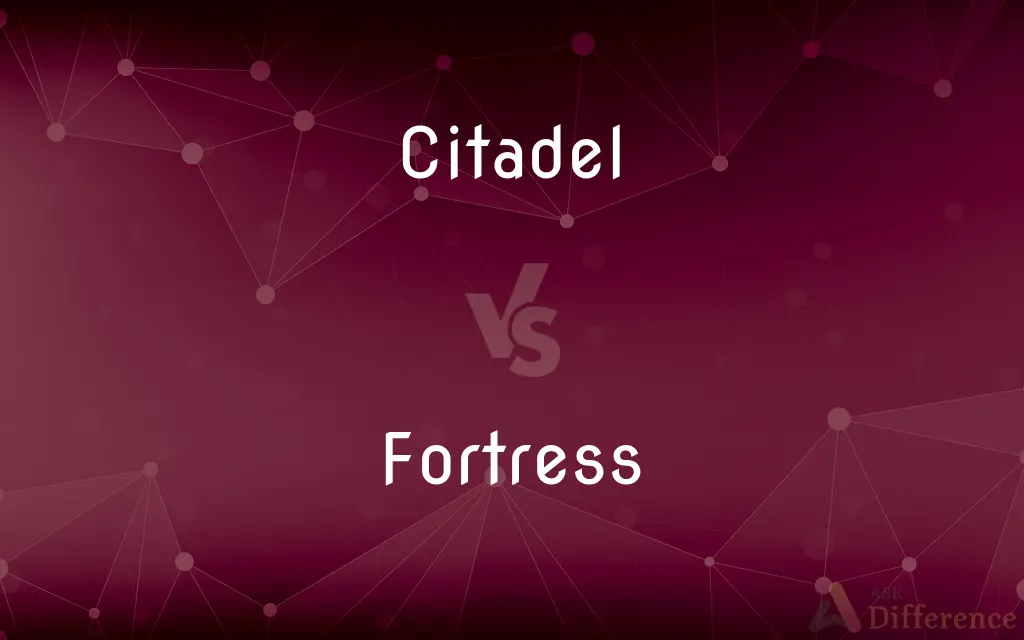Citadel vs. Fortress — What's the Difference?
Edited by Tayyaba Rehman — By Maham Liaqat — Updated on March 20, 2024
A citadel is a fortress within a city, serving as a last line of defense, while a fortress is a large, fortified place designed to protect against attacks.

Difference Between Citadel and Fortress
Table of Contents
ADVERTISEMENT
Key Differences
A citadel is essentially a strong core within a larger fortification or city, often situated on high ground to provide strategic advantages and serve as a final refuge or command center in the event of a siege. It's designed to ensure the security of the city's most vital elements, including its leaders and military forces. A fortress, on the other hand, is a broad term for any fortified place, ranging from large castles to fortified military camps, intended to defend against enemy attacks. Fortresses are built for military purposes first and foremost, with their entire structure designed to resist sieges and assaults.
While citadels are part of urban structures and closely integrated with the cities they protect, offering shelter and a defensive position during an attack, fortresses often stand alone and can be located anywhere strategic, such as borders, coastlines, or controlling key routes. This distinction highlights their different roles and the contexts in which they are used. For instance, a citadel may house administrative and military leaders, serving as a symbol of authority and a last stand during a conflict, whereas fortresses are primarily military in nature, often housing troops and armaments.
The design and construction of citadels take into account not only military defense but also the need to sustain a prolonged siege, with provisions for water, food, and armaments. They are built to ensure that, even if the outer city falls, the citadel can hold out until relief comes. Fortresses, however, are designed with a broader range of defensive strategies in mind, including moats, thick walls, and artillery positions, to prevent the enemy from ever breaching its defenses.
Historically, citadels have also served as symbols of power and control, representing the authority of the ruling body within a city. They often include significant buildings like palaces or command centers. Fortresses, while also imposing, are more focused on the practical aspects of defense and control over strategic locations, without the same emphasis on administrative functions.
The key difference between a citadel and a fortress lies in their strategic purpose and location. Citadels are defensive strongholds within cities, acting as a final line of defense and a center of authority, while fortresses are independent structures focused on broader military defense without being tied to an urban setting.
ADVERTISEMENT
Comparison Chart
Location
Within a city, serving as a stronghold.
Can be located anywhere strategic.
Purpose
Last line of defense, refuge, command center.
Broad military defense, troop housing.
Integration
Integrated with city infrastructure.
Stands alone, focused on military objectives.
Design
Designed for prolonged sieges, includes provisions.
Designed for broad defense strategies.
Historical Role
Symbol of power and authority within a city.
Military focus, controlling strategic points.
Compare with Definitions
Citadel
Built to sustain occupants through long sieges.
Despite the siege, the citadel's wells and granaries kept its defenders fed and watered.
Fortress
A fortified place designed to protect against attacks.
The fortress on the border has stood guard for centuries against invaders.
Citadel
Acts as a last stand during sieges.
The city fell, but the rebels held out in the citadel for months.
Fortress
Incorporates comprehensive defensive features.
Its walls, moats, and towers made the fortress nearly impregnable.
Citadel
Houses city leaders and important functions.
The citadel not only offered protection but also served as the governor's residence.
Fortress
Can be found in strategic locations, not limited to cities.
The island fortress controlled access to the bay.
Citadel
A fortress within a city, providing a secure refuge.
The medieval citadel towered over the capital, ready to protect the king.
Fortress
Operates independently, focused on defense.
The ancient fortress was a self-contained military base.
Citadel
Often located on high ground within the city.
The citadel's position on the hill provided a commanding view of the surrounding area.
Fortress
Often houses troops and military equipment.
The fortress was always garrisoned, ready for any threat.
Citadel
A citadel is the core fortified area of a town or city. It may be a castle, fortress, or fortified center.
Fortress
A military stronghold, especially a strongly fortified town.
Citadel
A fortress in a commanding position in or near a city.
Fortress
A fortified place, especially a large, permanent military stronghold that often includes a town.
Citadel
A stronghold or fortified place; a bulwark.
Fortress
A fortified place; a large and permanent fortification, sometimes including a town; for example a fort, a castle; a stronghold; a place of defense or security.
Citadel
A strong fortress that sits high above a city.
Fortress
(chess) A position that, if obtained by the weaker side, will prevent penetration by the opposing side, generally achieving a draw.
Citadel
A stronghold or fortified place.
Fortress
(transitive) To furnish with a fortress or with fortresses; to guard, to fortify.
Citadel
An armoured portion of a warship, housing important equipment.
Fortress
A fortified place; a large and permanent fortification, sometimes including a town; a fort; a castle; a stronghold; a place of defense or security.
Citadel
A Salvation Army meeting place.
Fortress
To furnish with a fortress or with fortresses; to guard; to fortify.
Citadel
A fortress in or near a fortified city, commanding the city and fortifications, and intended as a final point of defense.
Fortress
A fortified defensive structure
Citadel
A stronghold into which people could go for shelter during a battle
Common Curiosities
Have modern military strategies made citadels and fortresses obsolete?
While modern warfare has evolved, the strategic principles behind citadels and fortresses, like controlling key locations and protecting vital assets, remain relevant. However, the structures themselves are less commonly built today due to advances in military technology.
Why are citadels often built on high ground?
High ground offers strategic advantages, such as better visibility and defense against attacks, making it an ideal location for a citadel.
What is the main difference between a citadel and a fortress?
A citadel is a fortress within a city, serving as a last refuge, while a fortress is a large, fortified place designed for broad military defense.
How were citadels and fortresses supplied during sieges?
Citadels often had storerooms for food, water, and arms, designed to outlast sieges. Fortresses relied on their strategic location for supply lines and were designed to store supplies or facilitate quick resupply efforts.
Can a fortress become a citadel?
In essence, no, because a citadel is defined by its role and location within an urban area, whereas a fortress's function and location are more varied.
What factors influence the design of a citadel compared to a fortress?
Citadel designs are influenced by the need to integrate with city defenses, provide refuge, and maintain command functions, while fortress designs focus on maximizing defensive capabilities and military efficiency, often in varied terrains.
What kind of defensive features might a fortress have?
Fortresses may have thick walls, moats, artillery positions, and barracks for troops, designed to withstand sieges and assaults.
In historical sieges, which proved more resilient: citadels or fortresses?
Resilience varied based on many factors like design, location, and the besieging force's capabilities. Citadels, with their dual role of protection and command within a city, often symbolized a final stand, making their defense more desperate and resilient.
How do the locations of citadels and fortresses affect their design?
Citadels are designed with urban constraints and needs in mind, often incorporating existing city structures, while fortresses have more flexibility in design, optimized for military defense.
Can citadels serve non-military purposes?
Yes, besides being military strongholds, citadels have historically served as symbols of power, residences for rulers, and administrative centers.
Share Your Discovery

Previous Comparison
Yippie vs. Hippie
Next Comparison
Rescind vs. WithdrawAuthor Spotlight
Written by
Maham LiaqatEdited by
Tayyaba RehmanTayyaba Rehman is a distinguished writer, currently serving as a primary contributor to askdifference.com. As a researcher in semantics and etymology, Tayyaba's passion for the complexity of languages and their distinctions has found a perfect home on the platform. Tayyaba delves into the intricacies of language, distinguishing between commonly confused words and phrases, thereby providing clarity for readers worldwide.














































